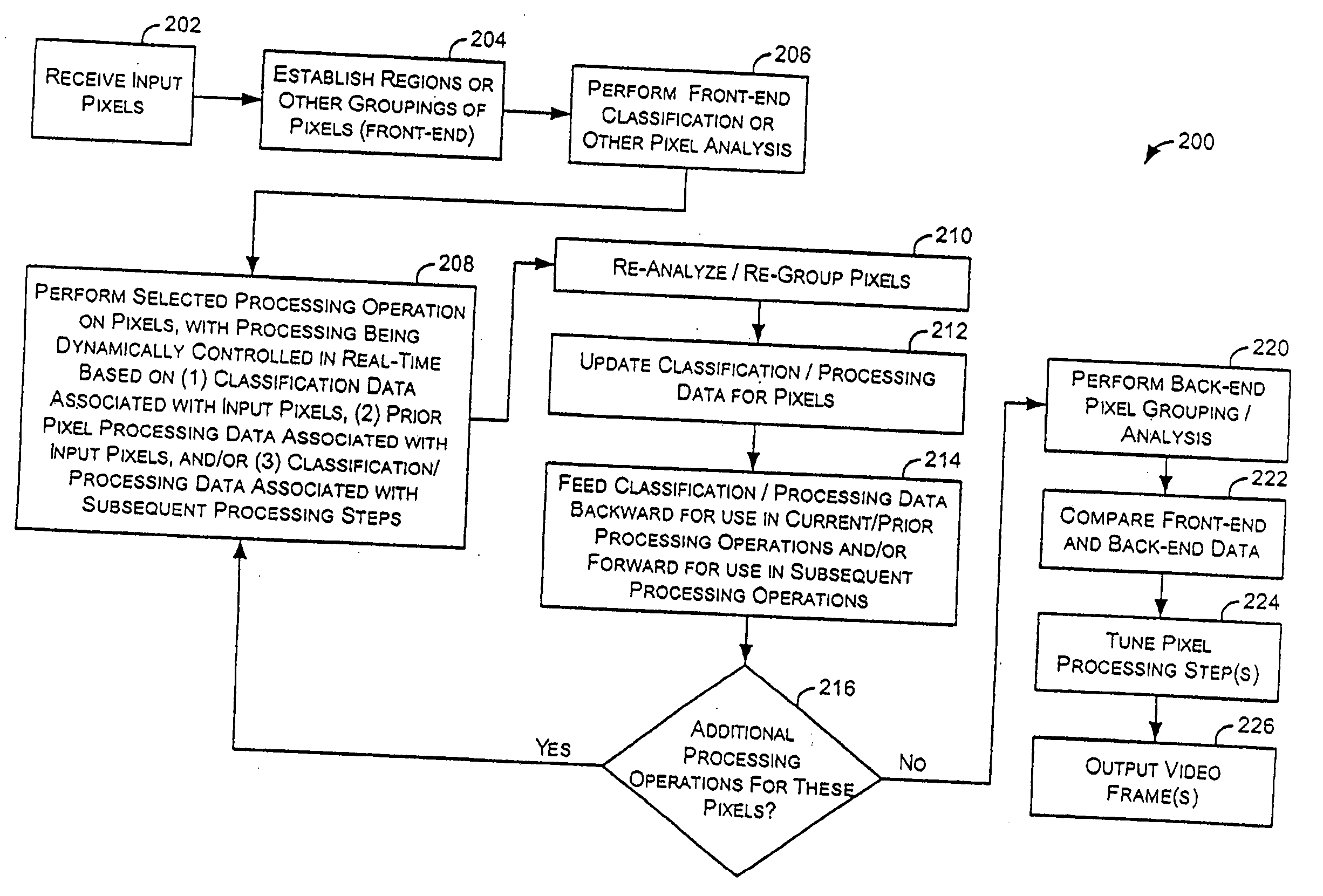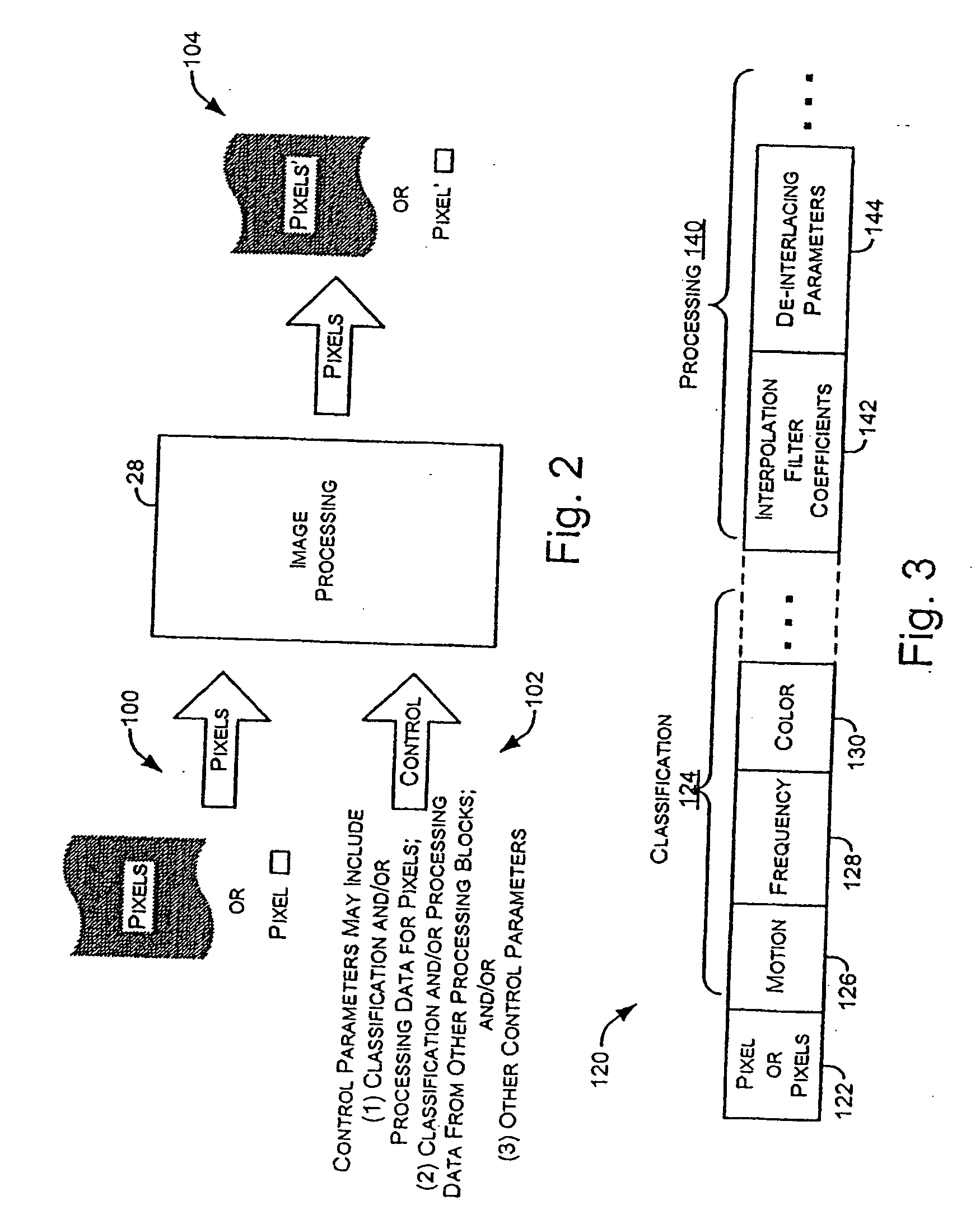Video image processing with remote diagnosis and programmable scripting
a video image and remote diagnosis technology, applied in the field of digital video, can solve problems such as error magnification, reduced image quality and processing efficiency, and increased redundancy and cos
- Summary
- Abstract
- Description
- Claims
- Application Information
AI Technical Summary
Problems solved by technology
Method used
Image
Examples
example 1
[0041]FIG. 1 schematically depicts an example of an image processing system 20. The image processing system 20 may include a block 22 for receiving and performing initial processing on an input video signal. The block 22 may be configured to handle analog and / or digital inputs. In the case of analog video, the block 22 may include subcomponents to capture and / or decode an analog video signal, so as to produce corresponding pixels representing the input video frame(s). For example, an analog video decoder including a suitable analog to digital converter (ADC) may be employed to produce pixels representing the input video frame. These pixels may then be clocked into or otherwise applied to the processing pipeline. In typical examples, the pixels are serially clocked into the system. In an example, the system 20 is fabricated within a single contiguous piece of silicon.
[0042] For analog video, a device such as the Philips 7119 may be used to provide the pixels to be captured by the pr...
example 2
[0080]FIG. 9 is a block diagram of one example of a conceptualization of portions of a system 900 for processing a digital video signal, such as for viewing on a high-definition television (HDTV) or like display 902. In this example, the system 900 includes a signal preprocessor 904. The signal preprocessor 904 receives and preprocesses one or more input signals, such as a digital video signal from a digital videocamera or a digital video signal of a digital television broadcast. An output of the signal preprocessor 904 is coupled to an input of a memory 906. The video pixel data and accompanying audio data of the resulting preprocessed signal is typically provided to and stored in a respective designated portion of the memory 906. Image analysis or processing stages 908A-N are also coupled to the memory 906. The pixel data stored in the memory 906 undergoes image analysis or processing by one or more of the stages 908A-N. An accompanying stage controller 910A-N is respectively coup...
example 3
[0114]FIG. 17 is a block diagram illustrating generally one example of portions of the memory 906 in more detail. In this example, the memory 906 includes a first-in-first-out frame buffer 1700 that receives a programmable number of frames 1702A-N of pixel data from the signal preprocessor 904. During the time when the pixel data frames 1702A-N are stored in the frame buffer, they are accessed and processed by the image analysis or processing stages 908, which typically results in the pixel data being altered (perhaps multiple times) before it is output by the frame buffer 1700 to the DTV display 902. In an illustrative example, the frame buffer 1700 includes about 30 to 40 frames of pixel data, which is stored in about 128 Mbytes of dynamic random access memory (DRAM). However, in another example, the frame buffer 1700 can be programmed to store a different number of frames of pixel data, or to use a different amount or type of memory.
[0115]FIG. 17 also illustrates tag data being ...
PUM
 Login to View More
Login to View More Abstract
Description
Claims
Application Information
 Login to View More
Login to View More - R&D
- Intellectual Property
- Life Sciences
- Materials
- Tech Scout
- Unparalleled Data Quality
- Higher Quality Content
- 60% Fewer Hallucinations
Browse by: Latest US Patents, China's latest patents, Technical Efficacy Thesaurus, Application Domain, Technology Topic, Popular Technical Reports.
© 2025 PatSnap. All rights reserved.Legal|Privacy policy|Modern Slavery Act Transparency Statement|Sitemap|About US| Contact US: help@patsnap.com



